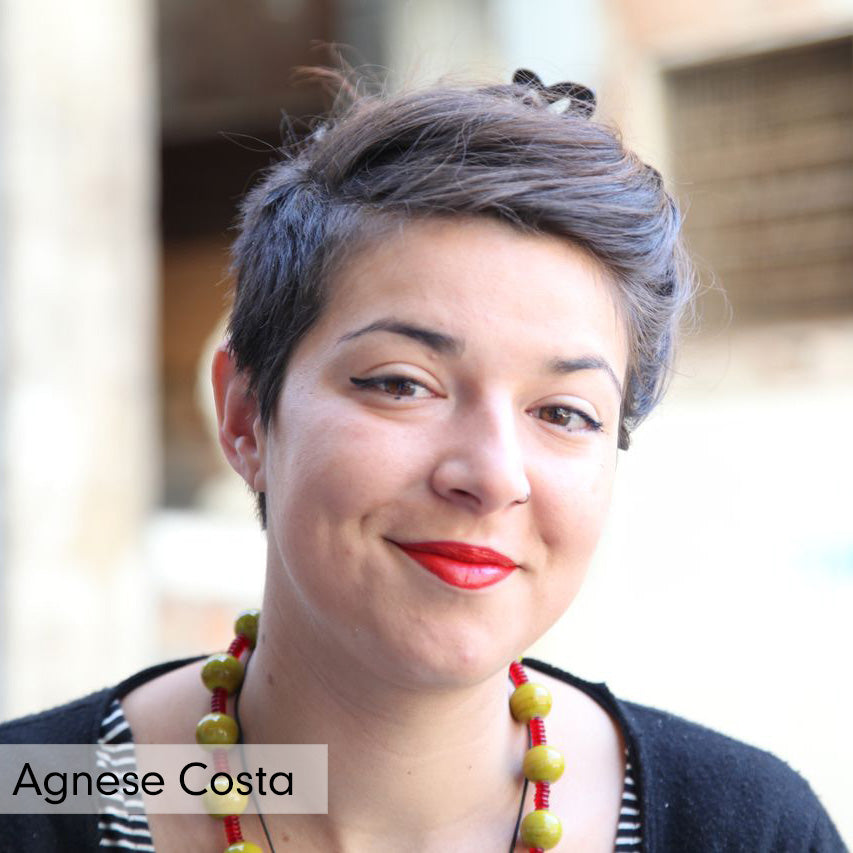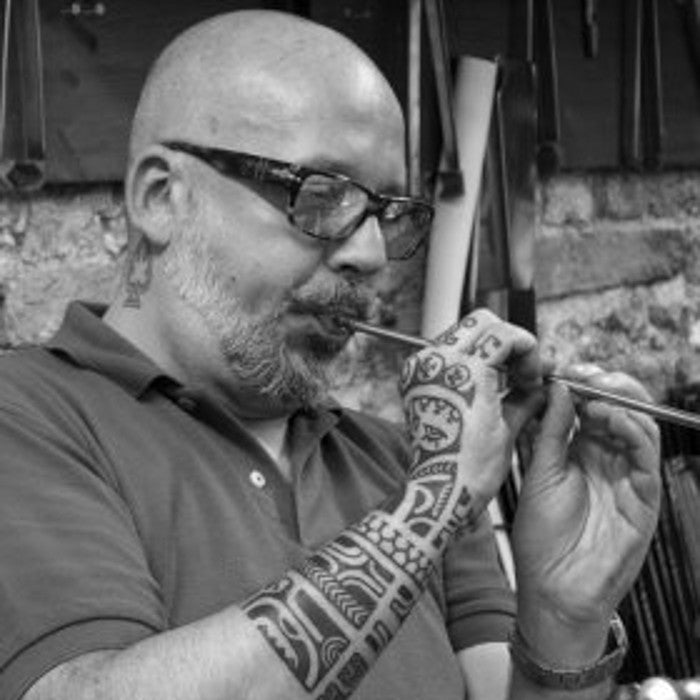It’s a sunny Friday of early May. The climate is ideal for sightseeing and discover Venice and its hidden corners, as are doing thousands of tourists arrived from all over the world. We, instead, are in a waterbus, heading towards Campo Santa Maria Mater Domini: we have arranged a meeting with the glassmaster Igor Balbi in his studio.
Igor is specialised in glass processing using the a lume technique – the only one in the world making goblets with it - and is one of the most talented artist in town, so much that a technique has its name (incalmo Balbi) and the Corning Museum of Glass ( http://www.cmog.org ) is working on a TV documentary that will feature his work. When we arrive it’s still early and we decide to stop at a bar. The Campo welcomes us with its Renaissance buildings: in such a lovely place it’s definitely nice to spend a few minutes with a coffee. Suddenly though a cheerful voice of a man greets us: here’s Igor Balbi with his fiancée Agnese Costa! They join us and we all drink coffee while he tells us anecdotes about Murano glass, the atelier, and the palazzo where they live and work together, Igor creating goblets and sculptures, Agnese creating some delicious Murano glass jewellery. But it's time to work... And to discover how Igor's adventure has begun.
Igor, when have you started working with glass? 
In the summer of 1994, when I was 19 years old. I began by chance: one day my father, a master glassmaker, said to me: “Today you’re coming with me in the lab” .
I was at that time when a young man tries to figure out what he wants to do with his life. So I followed him, convinced to immediately start working with glass. Well, I have spent six months watching other people creating with glass.
And you are still using that technique. My dad was strongly convinced – and today I am too – that one of the best ways to learn the Muranese techniques is to observe experts working. After this peculiar internship, I started with the basics making small objects with the a lume technique: sweets, balls, portions of small animals that were then refined by more experienced hands.
I exclusively work with the a lume technique.
That’s interesting. Where does the idea of creating goblets using the a lume technique come from? It’s rather peculiar.
 After the internship I thought: either I become good and specialized in making art with Murano glass or I will start a new career in another field. I started with sculptures, but then my name begun to be associated with a great Muranese artist: Lucio Bubacco. That made me angry because I wanted to find “my way”, because I wanted people to identify me with a style recognisable as typically mine. There was another interesting artist in Murano, Cesare Toffolo , who made great goblets using borosilicate glass. Fascinated by the use of this glass and his skills, I begun making goblets. But with the technique that I knew more: a lume. My father was rather skeptical and kept and saying that it was not possible; and in fact nobody had every done that before obtaining decent results. I was stubborn enough to spend 8 months on tests – mainly unsuccessful – and headaches. In the end though, thanks to my determination, I got the results that I wanted.
After the internship I thought: either I become good and specialized in making art with Murano glass or I will start a new career in another field. I started with sculptures, but then my name begun to be associated with a great Muranese artist: Lucio Bubacco. That made me angry because I wanted to find “my way”, because I wanted people to identify me with a style recognisable as typically mine. There was another interesting artist in Murano, Cesare Toffolo , who made great goblets using borosilicate glass. Fascinated by the use of this glass and his skills, I begun making goblets. But with the technique that I knew more: a lume. My father was rather skeptical and kept and saying that it was not possible; and in fact nobody had every done that before obtaining decent results. I was stubborn enough to spend 8 months on tests – mainly unsuccessful – and headaches. In the end though, thanks to my determination, I got the results that I wanted.
We can then say that you great determination has brought you to the level where you are today.
Determination and great work. To date, I am one of the few artists in the world producing exclusive stemware with a technique that 15 years ago was considered unsuitable for the purpose.
And that’s the reason why the Abate Zanetti Glass School of Murano wanted you as a teacher for their classes, because of the level of innovation and the results you have introduced.
I think so. Although I do not teach anymore because work absorbs most my time.
Igor, since we are talking about school, what would you say to young students who want to learn the glass techniques? To come to Murano and study there?
Only if they are really passionate and already have a basic knowledge. The Scuola Abate Zanetti offers private lessons on how to work with glass. Students are in contact with teachers coming from the reality of Muranese furnaces and with the glass industry; and that’s a very good thing. But what I would recommend is to choose targeted lessons, not for beginners but rather for those willing to enrich their skills and abilities.
Going back to your work, where does your inspiration come from? Nature and landscapes of the lagoon, Venetian architecture and history, or traditional themes of the Muranese culture?
Nothing like that. I’m sorry if I disappoint your readers or you, but I’m not inspired by anything. Let me explain: it’s the material itself that takes a shape as I manipulate it. The starting point is just a basic and general idea, then I let the glass and the technique lead me. It’s like going out with a friend saying “We shall meet in Piazza San Marco” without being precise on the destination. In this case, my friend is glass: we both know that we want to create a goblet, with certain colour accents, or with the inclusion of a certain detail. That’s the starting point: the rest comes by itself. This modus operandi allows me to experiment all the time, and experimentation has a role key in my job.
For this reason each glass is truly unique.
You see, the fact is I can make two identical objects, but I simply refuse. I'm not interested in doing that.
I guess it wouldn’t be so amusing after all…
Actually, more absurd than dull. Once a client has asked me to create six identical glasses. I refused. I don’t get it! It's like asking a painter to reproduce the exact same picture six times and then hang them on the wall, side by side. What’s the meaning of it?
Speaking of uniqueness, t he technique you have developed is quite complicated and a continuous experimentation. What happens when you realise that something went wrong in the execution? Do you have to throw everything away and start from scratch?
At this point in my career, if the error is just a small slip, I can correct it. If the mistake is irreparable, then I have to throw everything away. You have to consider that my goals are perfection and the highest possibile quality: when something does not work as I’d like, I must start from scratch. Sometimes it’s not a technical mistake though. It’s an error in the colour rendering: and again, if I don’t like it I have to start all over again. This happens especially with the incamiciato products which feature several layers of different glass. Because of some unexpected reflections, or minerals contained in the glass, the final result may not be what I expected.
It could be a pleasant surprise, or not. In this second case the work done so far is to throw away. Why am I so drastic? Because my creations must respond to quality standards and also to my taste.
After all you are the father of your artwork, and you have to be satisfied with what you have accomplished, isn’t it?
Indeed! Sometimes they have said to me: "You should use more vivid colors, you should do this and that". No way. “I do not care!” , that's my answer.
Using your previous metaphor, it would be like asking a painter to paint a canvas using certain colours rather than what he sees and what he wants to express.
Exactly.
 When you step in the studio a dynamic artistic atmosphere welcoms you. The core products are, obviously, Igor’s goblets. But you'll also find Agnese’s creations and artworks by other artists, made of glass or not. For example the center of the main room is dominated by HONEY, a glass and porcelain chandelier designed and handmade by Andrea Reggiani ( http://www.reggianiceramica.com ). The chandelier is made from thin steel wires. At the end of some wires hang special lightbulbs, made in the Netherlands: the filaments produce a pleasing golden light. From other wires hang some amber elements in Murano glass, made by Igor.
When you step in the studio a dynamic artistic atmosphere welcoms you. The core products are, obviously, Igor’s goblets. But you'll also find Agnese’s creations and artworks by other artists, made of glass or not. For example the center of the main room is dominated by HONEY, a glass and porcelain chandelier designed and handmade by Andrea Reggiani ( http://www.reggianiceramica.com ). The chandelier is made from thin steel wires. At the end of some wires hang special lightbulbs, made in the Netherlands: the filaments produce a pleasing golden light. From other wires hang some amber elements in Murano glass, made by Igor.
Each glass element is equipped with a magnet and one porcelain dish of hexagonal shape adheres to each magnet. It is possible to remove dishes from the chandelier, use them, then wash and put them once again on their original place.
The porcelain is special and mostly used for lighting: its thinnes (approximately 2 mm or 0.08 in) makes it almost transparent. Light filters and spreads elegantly into the surrounding environment. Andrea's great skills enable him to work with such an exclusive - but difficult to shape - material.
If you are in Venice, be sure to pay a visit there!
Some pictures of Igor's works:
Works by other artists:
Details of the HONEY chandelier:








Hinterlasse einen Kommentar
Alle Kommentare werden vor der Veröffentlichung geprüft.
Diese Website ist durch hCaptcha geschützt und es gelten die allgemeinen Geschäftsbedingungen und Datenschutzbestimmungen von hCaptcha.